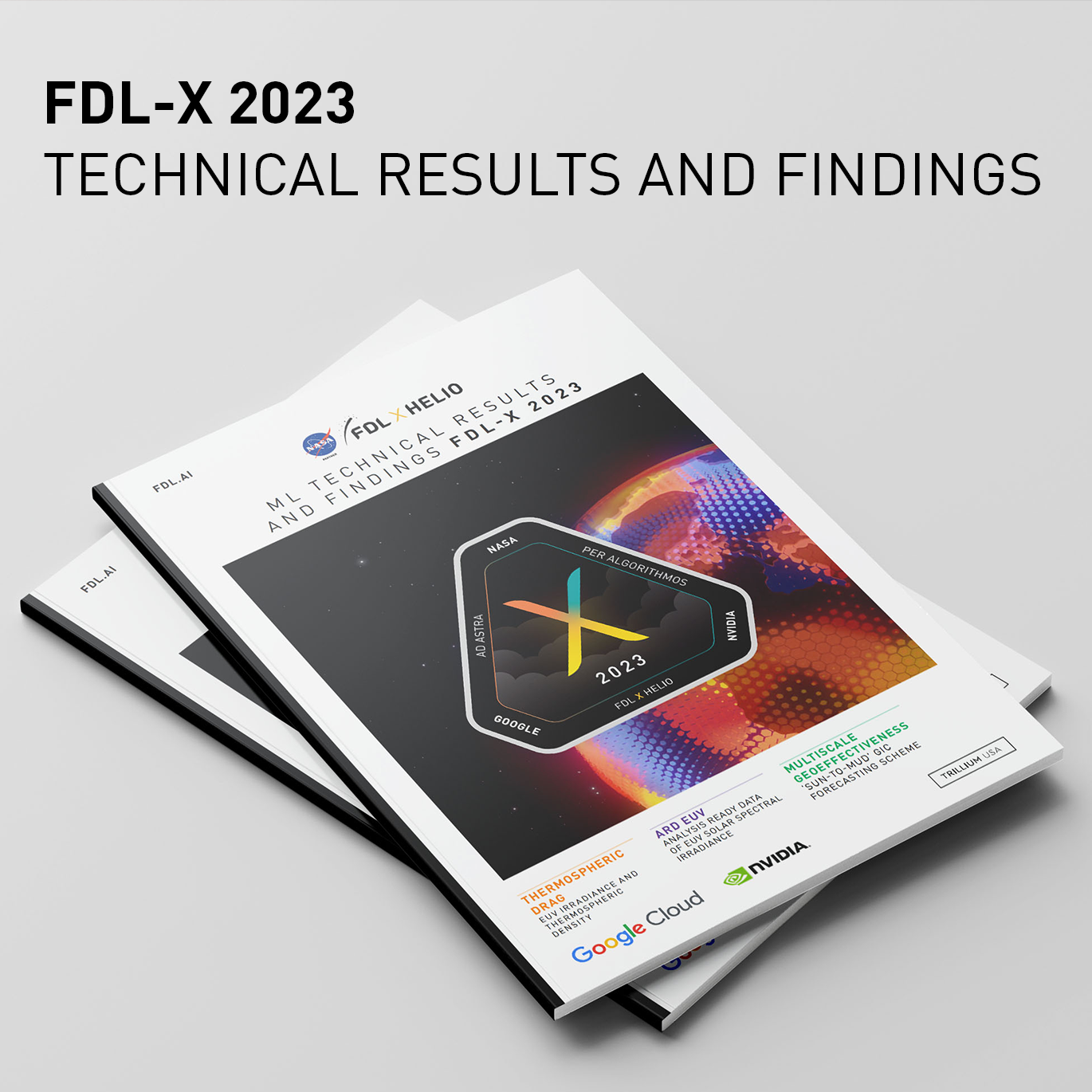A DECADE OF FIRSTS: FDL-X AND GOOGLE CLOUD CONTEMPLATE WHAT’S NEXT IN AI FOR SCIENCE.
FDL-X and FDL Europe have quietly been using AI to tackle humanity’s most pressing problems on Earth and in space for nearly a decade in close partnership with Google Cloud.
AI has been dominating the headlines recently. We’ve seen some astonishing progress in generative AI. However, out of the limelight another revolution has been quietly gaining momentum - the application of AI to applied problems in science: climate, disaster response, energy efficiency, space situational awareness, health and deep space exploration.
The application of AI in these areas has been so rapid and profound, it’s difficult to take it all in. Buried in science journals, data and code repos on GCP and jargon-filled technical memos is a treasure trove of technical and scientific progress that has blasted through pernicious problems and, in many cases, unlocked bold new capabilities for space agencies and scientific institutions. Perhaps due to the innate suspicion of the science community to hyperbole, the rapid and profound progress in the application of AI for science has been celebrated cautiously, buried in careful language of science, where sometimes implications require a second or third read before the “oh wow” really hits.
“Perhaps due to the innate suspicion of the science community to hyperbole, the rapid and profound progress in the application of AI for science has been celebrated cautiously’”
This is of course open science’s inherent promise; that a tricky problem once solved and accepted by the community, catalyzes a wave of previously unconsidered application. This ability to combine and derive new opportunities, surfing a wave of rapid discovery is an exciting aspect of the AI for science revolution. Techniques such as physics-informed learning, causal discovery, continuous learning and foundation models are transforming how we think about science and discovery. New scientific insight can be extracted from the petabytes of data being generated. Data and algorithms are now key tools in the science toolbox. But the revolution is more than that; in the same way that container shipping changed global trade, the ability to package ‘insight’ within a data product and co-lab allows science to be glued together like Legos.
This concept of integrated AI, sometimes called a ‘Mixture of Experts’ is a key focus of FDL-X. We believe that complex, interconnected science problems like space weather, climate, health and space exploration lend themselves to orchestrated approaches working in concert - which is why a unified development and AI serving platform like GCP is key.
AI for science and the cloud are intrinsically linked.
Cloud technology and AI are often bundled together on deep tech lists (you’ve seen them, often with IOT, blockchain, quantum, the metaverse et al) but the actual mechanisms of how AI and cloud tech work hand in glove to drive applied science aren’t often talked about. Put simply, AI research efforts like FDL-X and FDL Europe wouldn’t be possible without cloud infrastructure. The data handling at scale, availability of CPUs, GPUs and TPUs as needed, as well as numerous tools to support AI pipeline development and deployment reduce the barriers to teams doing great work.
It’s perhaps worth taking a breath to reflect on how cloud technology has super-charged the research of organizations like FDL.
The Cloud enables science to be ‘living’ and seamlessly shared.
The Cloud enables enormous datasets to be ingested into AI pipelines from anywhere
AI projects can spin-up as little or as much compute as they need on demand
Interdisciplinary teams can collaborate effortlessly from anywhere from any laptop
Multiple AI pipelines can be stitched together to make an orchestrated outcome
FDL.ai brings together some of the brightest interdisciplinary minds in space science, Earth science, health, AI and ML, academia, and the commercial sector to tackle here-and-now challenges for NASA in the United States and ESA in Europe.
Over eight weeks, researchers cracked the following questions:
Can we develop a live stream of the Sun and provide analysis-ready data of ultraviolet irradiance for the scientific community?
Can we improve our ability to model thermospheric drag (which affects satellite orbits) by integrating ultraviolet irradiance data?
Can we provide reliable forecasts of the effect of geomagnetic storms on the Earth?
Can we use machine learning to build a near-real-time warning system for potentially dangerous solar weather events?
Can we harness large language models (LLMs) to provide accurate and detailed information to natural disaster response and recovery teams?
Can we develop foundation models for analyzing synthetic aperture radar (SAR) Earth observation data that can generalize to a range of downstream tasks?
FDL.AI is a model of how global teams of experts can come together to blast through difficult problems, and Google Cloud enables distributed teams to work seamlessly together on enormous datasets; its significance to FDL.ai’s work cannot be overstated. Google Cloud’s robust infrastructure, versatile services (including TensorFlow and Cloud-AI pre-trained ML models), and extensive ecosystem provide a powerful foundation for AI development and deployment. Google Cloud’s storage capabilities and scalable computing resources allow teams to handle large datasets, and BigQuery allows for efficient data analysis. Moreover, Google Cloud’s emphasis on security and compliance ensures that AI projects meet rigorous industry standards.
FDL-X 2023 Challenges
FDL Europe 2023 Challenges
Looking Forward
Thank you to our partners at Google Cloud for supporting the next frontier in research excellence. Read more about our 2023 research challenges and get involved at fdleurope.org (FDL Europe) and fdl.ai (FDL-X).
“Google Cloud has enabled us to keep up with the big AI labs, and they’ve been steadfast in their support and ambition for a better future, for all humankind. Cloud-based AI technology allows us to think big, operate globally, and deliver reliably. Without Google Cloud, we wouldn’t have the continued ability to over-deliver, which we always aspire to,” said James Parr, Founder of FDL.ai and CEO of Trillium Technologies, which operates FDL.ai in partnership with NASA and ESA.
FDL.AI’s mission is grounded in open science in order to enable scientists, scholars, and science enthusiasts alike by providing access to machine learning projects, code, MLOps, server-side compute, analysis ready data, and maintained benchmark datasets. To this end, all of FDL.ai’s research will be available at SpaceML.org in the coming months.
Learn more about past and present FDL.AI programs at fdleurope.org and fdl.ai.








